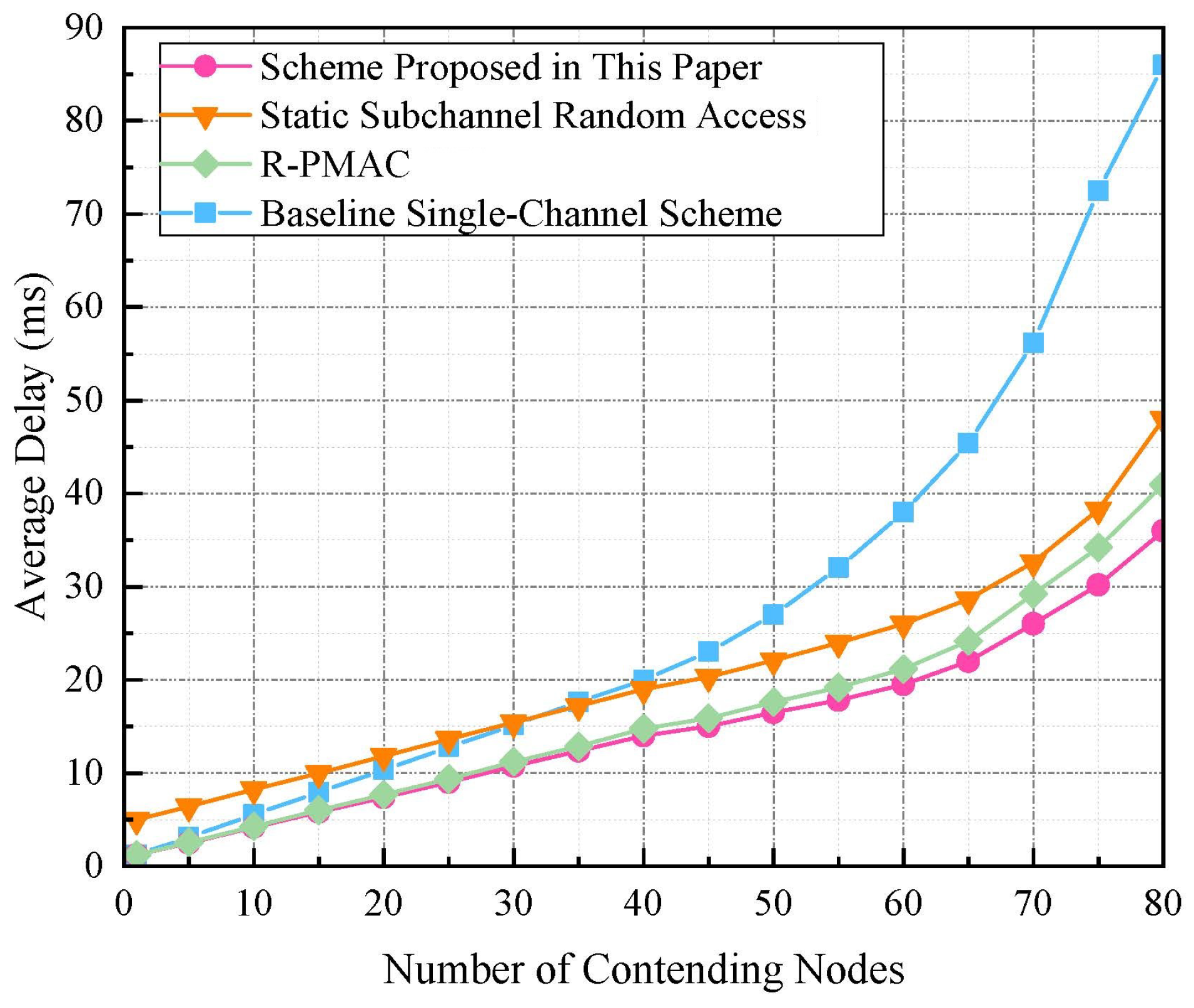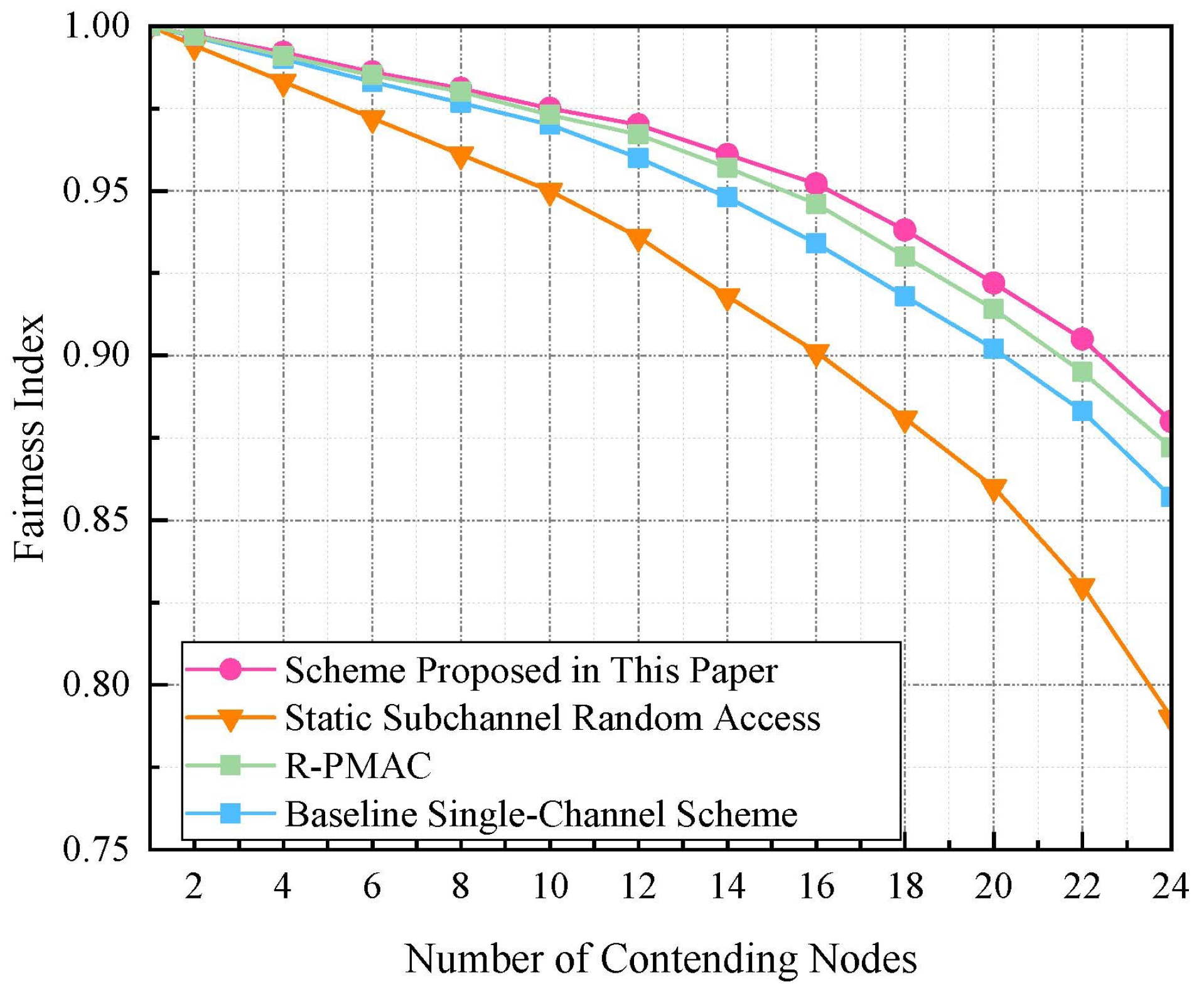Adaptive Channel Division and Subchannel Allocation for Orthogonal Frequency Division Multiple Access-Based Airborne Power Line Communication Networks
Abstract
1. Introduction
- Development of an OFDMA-based multichannel CSMA/CA protocol: We have developed a novel multichannel CSMA/CA protocol tailored specifically for airborne PLC systems. This protocol significantly enhances network efficiency by optimizing throughput, minimizing delay, and ensuring equitable distribution of resources among nodes.
- Adaptive algorithms for dynamic subchannel adjustment: Our study introduces two adaptive algorithms. The first dynamically adjusts the number of subchannels in response to fluctuations in node count and variations in network conditions. The second algorithm optimally allocates these subchannels to individual nodes, considering the quality and congestion level of each subchannel.
- Validation through extensive simulations: The efficacy and advantages of our proposed algorithms are validated through comprehensive simulations. Results from these simulations demonstrate substantial enhancements in network throughput, reduced latency, and improved fairness among nodes.
2. Related Work
2.1. Empirical Validation of the HomePlug AV2 Protocol for Aviation Applications
2.2. Advancements in MAC Layer Enhancement
3. System Model and Saturated MAC Throughput Definition
4. Channel Division
4.1. Problem Formulation
4.2. Algorithm Implementation
- Node count N.
- The quality discrepancy across subchannels, quantified by their variance in the signal-to-noise ratio (SNR), denoted as .
- The number of successful MAC frame transmissions during the CSMA/CA phase of each Beacon Period, denoted as .
| Algorithm 1 Adaptive optimization of subchannel count. |
|
4.3. Computational Complexity Analysis
5. Subchannel Allocation
5.1. Metric Design
5.2. Algorithm Implementation
| Algorithm 2 Subchannel allocation in OFDMA-based PLC networks. |
|
5.3. Computational Complexity Analysis
6. Performance Evaluation
6.1. Simulation Setup
6.2. Simulation Results
- The robust preamble-based MAC (R-PMAC) method proposed in [29], which is designed for robust transmission in noisy industrial settings. This method utilizes a preamble-based approach that enhances collisions management and ensures reliable frame delivery.
- The opportunistic random-access scheme introduced in [34], which optimizes user access efficiency by dynamically adjusting backoff timings based on the real-time variances in channel-states.
- A conventional MAC mechanism that treats the entire bandwidth as a single channel, without channel division. This serves as a baseline to highlight the advantages of implementing channel division.
7. Conclusions
Author Contributions
Funding
Institutional Review Board Statement
Informed Consent Statement
Data Availability Statement
Conflicts of Interest
References
- Coutinho, Y.F.; Camponogara, A.; Filomeno, M.d.L.; de Campos, M.L.R.; Tonello, A.M.; Ribeiro, M.V. Two Decades of Research Progress in Resource Allocation for PLC Systems: From Core Concepts to Frontiers. IEEE Commun. Surv. Tutor. 2024, 26, 1710–1747. [Google Scholar] [CrossRef]
- de Oliveira, R.M.; Vieira, A.B.; Latchman, H.A.; Ribeiro, M.V. Medium Access Control Protocols for Power Line Communication: A Survey. IEEE Commun. Surv. Tutor. 2019, 21, 920–939. [Google Scholar] [CrossRef]
- Beshir, A.H.; Negri, S.; Wu, X.; Liu, X.; Wan, L.; Spadacini, G.; Pignari, S.A.; Grassi, F. Behavioral Model of G3-Powerline Communication Modems for EMI Analysis. Energies 2023, 16, 3336. [Google Scholar] [CrossRef]
- Gonzalez-Ramos, J.; Uribe-Perez, N.; Sendin, A.; Gil, D.; de la Vega, D.; Fernandez, I.; Nunez, I.J. Upgrading the Power Grid Functionalities with Broadband Power Line Communications: Basis, Applications, Current Trends and Challenges. Sensors 2022, 22, 4348. [Google Scholar] [CrossRef] [PubMed]
- Pinero-Escuer, P.J.; Malgosa-Sanahuja, J.; Manzanares-Lopez, P.; Munoz-Gea, J.P. Homeplug-AV CSMA/CA Cross-Layer Extension for QoS Improvement of Multimedia Services. IEEE Commun. Lett. 2014, 18, 704–707. [Google Scholar] [CrossRef]
- Taherinejad, N.; Lampe, L.; Mirabbasi, S. An Adaptive Impedance-Matching System for Vehicular Power Line Communication. IEEE Trans. Veh. Technol. 2017, 66, 927–940. [Google Scholar] [CrossRef]
- Degardin, V.; Laly, P.; Lienard, M.; Degauque, P. Investigation on power line communication in aircrafts. IET Commun. 2014, 8, 1868–1874. [Google Scholar] [CrossRef]
- Degauque, P.; Stievano, I.S.; Pignari, S.A.; Degardin, V.; Canavero, F.G.; Grassi, F.; Canete, F.J. Power-Line Communication: Channel Characterization and Modeling for Transportation Systems. IEEE Veh. Technol. Mag. 2015, 10, 28–37. [Google Scholar] [CrossRef]
- Camponogara, A.; Oliveira, T.R.; Machado, R.; Finamore, W.A.; Ribeiro, M.V. Measurement and Characterization of Power Lines of Aircraft Flight Test Instrumentation. IEEE Trans. Aerosp. Electron. Syst. 2019, 55, 1550–1560. [Google Scholar] [CrossRef]
- Degardin, V.; Junqua, I.; Lienard, M.; Degauque, P.; Bertuol, S. Theoretical Approach to the Feasibility of Power-Line Communication in Aircrafts. IEEE Trans. Veh. Technol. 2013, 62, 1362–1366. [Google Scholar] [CrossRef]
- Buticchi, G.; Wheeler, P.; Boroyevich, D. The More-Electric Aircraft and Beyond. Proc. IEEE 2023, 111, 356–370. [Google Scholar] [CrossRef]
- Bai, T.; Zhang, H.; Wang, J.; Xu, C.; Elkashlan, M.; Nallanathan, A.; Hanzo, L. Fifty Years of Noise Modeling and Mitigation in Power-Line Communications. IEEE Commun. Surv. Tutor. 2021, 23, 41–69. [Google Scholar] [CrossRef]
- Alberto Del Puerto-Flores, J.; Luis Naredo, J.; Pena-Campos, F.; Del-Valle-Soto, C.; Valdivia, L.J.; Parra-Michel, R. Channel Characterization and SC-FDM Modulation for PLC in High-Voltage Power Lines. Future Internet 2022, 14, 139. [Google Scholar] [CrossRef]
- Wang, B.; Cao, Z. A Review of Impedance Matching Techniques in Power Line Communications. Electronics 2019, 8, 1022. [Google Scholar] [CrossRef]
- Ribeiro, M.V.; Filomeno, M.D.L.; Camponogara, A.; Oliveira, T.R.; Moreira, T.F.; Galli, S.; Poor, H.V. Seamless Connectivity: The Power of Integrating Power Line and Wireless Communications. IEEE Commun. Surv. Tutor. 2024, 26, 1–40. [Google Scholar] [CrossRef]
- Vlachou, C.; Herzen, J.; Thiran, P. Fairness of MAC Protocols: IEEE 1901 vs. 802.11. In Proceedings of the 2013 17th IEEE International Symposium on Power Line Communications and Its Applications (ISPLC), Johannesburg, South Africa, 24–27 March 2013; IEEE: Piscataway, NJ, USA, 2013; pp. 58–63. [Google Scholar]
- Cano, C.; Malone, D. When Priority Resolution Goes Way Too Far: An Experimental Evaluation in PLC Networks. In Proceedings of the 2015 IEEE International Conference on Communications (ICC), London, UK, 8–12 June 2015; IEEE: Piscataway, NJ, USA, 2015; pp. 952–957. [Google Scholar]
- Ayar, M.; Latchman, H.A. A Delay and Throughput Study of Adaptive Contention Window Based HomePlug MAC with Prioritized Traffic Classes. In Proceedings of the 2016 International Symposium on Power Line Communications and Its Applications (ISPLC), Bottrop, Germany, 20–23 March 2016; IEEE: Piscataway, NJ, USA, 2016; pp. 126–131. [Google Scholar]
- Sheng, Z.; Tian, D.; Leung, V.C.M.; Bansal, G. Delay Analysis and Time-Critical Protocol Design for In-Vehicle Power Line Communication Systems. IEEE Trans. Veh. Technol. 2018, 67, 3–16. [Google Scholar] [CrossRef]
- Zhu, Q.; Chen, Z.; He, X. Resource Allocation for Relay-Based OFDMA Power Line Communication System. Electronics 2019, 8, 125. [Google Scholar] [CrossRef]
- Berger, L.T.; Schwager, A.; Pagani, P.; Schneider, D.M. MIMO Power Line Communications. IEEE Commun. Surv. Tutor. 2015, 17, 106–124. [Google Scholar] [CrossRef]
- Chen, Z.; Liu, Y.; Liu, R.; Yuan, J.; Han, D. Improved CSMA/CA Algorithm Based on Alternative Channel of Power Line and Wireless and First-Time Idle First Acquisition. IEEE Access 2019, 7, 41380–41394. [Google Scholar] [CrossRef]
- Bertuol, S.; Junqua, I.; Degardin, V.; Degauque, P.; Lienard, M.; Dunand, M.; Genoulaz, J. Numerical Assessment of Propagation Channel Characteristics for Future Application of Power Line Communication in Aircraft. In Proceedings of the 10th International Symposium on Electromagnetic Compatibility (EMC Europe), York, UK, 26–30 September 2011; pp. 506–511. [Google Scholar]
- Zhang, R.; Wu, X.; Lou, Y.; Yan, F.G.; Zhou, Z.; Wu, W.; Yuen, C. Channel Training-Aided Target Sensing for Terahertz Integrated Sensing and Massive MIMO Communications. IEEE Internet Things J. 2024, 1. [Google Scholar] [CrossRef]
- Sarvghadi, M.A.; Wan, T.C. Distributed and Efficient Slot Assignment-Alignment Protocol for Resource-Constrained Wireless IoT Devices. IEEE Internet Things J. 2023, 10, 8754–8772. [Google Scholar] [CrossRef]
- Chen, Z.; Zhi, L.; Chen, P.; Qi, Y. An MAC Layer Algorithm Based on Power Line-Wireless Dual Media Channels and Multiplexing. China Commun. 2022, 19, 78–91. [Google Scholar] [CrossRef]
- Hao, S.; Zhang, H.Y. A Cross-Layered Theoretical Model of IEEE 1901 Power-Line Communication Networks Considering Retransmission Protocols. IEEE Access 2021, 9, 28805–28821. [Google Scholar] [CrossRef]
- Hao, S.; Zhang, H. MAC Performance Analysis for Reliable Power-Line Communication Networks with ARQ Scheme. Sensors 2021, 21, 196. [Google Scholar] [CrossRef] [PubMed]
- Song, K.; Feng, B.; Wu, Y.; Gao, Z.; Zhang, W. R-PMAC: A Robust Preamble-Based MAC Mechanism Applied in Industrial Internet of Things. IEEE Internet Things J. 2024, 11, 623–637. [Google Scholar] [CrossRef]
- de Oliveira, R.M.; Vieira, L.F.M.; Vieira, M.A.M.; Vieira, A.B. A dynamic network coding MAC protocol for power line communication. Telecommun. Syst. 2021, 77, 359–375. [Google Scholar] [CrossRef]
- Ali, K.; Liu, A.X.; Pefkianakis, I.; Kim, K.H. Distributed Spectrum Sharing for Enterprise Powerline Communication Networks. IEEE-ACM Trans. Netw. 2021, 29, 1032–1045. [Google Scholar] [CrossRef]
- Qian, Y.; Wang, Z.; Li, J.; Zhang, T.; Shu, F. Sub-channel assignment and link schedule for In-Home power line communication network. IET Commun. 2017, 11, 673–679. [Google Scholar] [CrossRef]
- Yoon, S.G.; Kang, D.; Bahk, S. Multichannel CSMA/CA Protocol for OFDMA-Based Broadband Power-Line Communications. IEEE Trans. Power Deliv. 2013, 28, 2491–2499. [Google Scholar] [CrossRef]
- Dong, R.; Ouzzif, M.; Saoudi, S. Opportunistic Random-Access Scheme Design for OFDMA-Based Indoor PLC Networks. IEEE Trans. Power Deliv. 2012, 27, 2073–2081. [Google Scholar] [CrossRef]
- Sheng, Z.; Kenarsari-Anhari, A.; Taherinejad, N.; Leung, V.C.M. A Multichannel Medium Access Control Protocol for Vehicular Power Line Communication Systems. IEEE Trans. Veh. Technol. 2016, 65, 542–554. [Google Scholar] [CrossRef]
- Vo, T.N.; Amis, K.; Chonavel, T.; Siohan, P. A Computationally Efficient Discrete Bit-Loading Algorithm for OFDM Systems Subject to Spectral-Compatibility Limits. IEEE Trans. Commun. 2015, 63, 2261–2272. [Google Scholar] [CrossRef]
- Yoon, S.G.; Bahk, S. Adaptive Rate Control and Contention Window-Size Adjustment for Power-Line Communication. IEEE Trans. Power Deliv. 2011, 26, 809–816. [Google Scholar] [CrossRef]
- Jung, M.; Chung, M.; Lee, T. MAC throughput analysis of HomePlug 1.0. IEEE Commun. Lett. 2005, 9, 184–186. [Google Scholar] [CrossRef]
- Bautista, P.A.B.; Urquiza-Aguiar, L.F.; Cardenas, L.L.; Igartua, M.A. Large-Scale Simulations Manager Tool for OMNeT plus plus: Expediting Simulations and Post-Processing Analysis. IEEE Access 2020, 8, 159291–159306. [Google Scholar] [CrossRef]
- Zimmermann, M.; Dostert, K. A multipath model for the powerline channel. IEEE Trans. Commun. 2002, 50, 553–559. [Google Scholar] [CrossRef]
- Salem, A.; Hamdi, K.A.; Alsusa, E. Physical Layer Security Over Correlated Log-Normal Cooperative Power Line Communication Channels. IEEE Access 2017, 5, 13909–13921. [Google Scholar] [CrossRef]
- Guo, C.; Sheng, M.; Wang, X.; Zhang, Y. Throughput Maximization with Short-Term and Long-Term Jain’s Index Constraints in Downlink OFDMA Systems. IEEE Trans. Commun. 2014, 62, 1503–1517. [Google Scholar] [CrossRef]





Disclaimer/Publisher’s Note: The statements, opinions and data contained in all publications are solely those of the individual author(s) and contributor(s) and not of MDPI and/or the editor(s). MDPI and/or the editor(s) disclaim responsibility for any injury to people or property resulting from any ideas, methods, instructions or products referred to in the content. |
© 2024 by the authors. Licensee MDPI, Basel, Switzerland. This article is an open access article distributed under the terms and conditions of the Creative Commons Attribution (CC BY) license (https://creativecommons.org/licenses/by/4.0/).
Share and Cite
Yan, R.; Li, Q.; Xiong, H. Adaptive Channel Division and Subchannel Allocation for Orthogonal Frequency Division Multiple Access-Based Airborne Power Line Communication Networks. Sensors 2024, 24, 7644. https://doi.org/10.3390/s24237644
Yan R, Li Q, Xiong H. Adaptive Channel Division and Subchannel Allocation for Orthogonal Frequency Division Multiple Access-Based Airborne Power Line Communication Networks. Sensors. 2024; 24(23):7644. https://doi.org/10.3390/s24237644
Chicago/Turabian StyleYan, Ruowen, Qiao Li, and Huagang Xiong. 2024. "Adaptive Channel Division and Subchannel Allocation for Orthogonal Frequency Division Multiple Access-Based Airborne Power Line Communication Networks" Sensors 24, no. 23: 7644. https://doi.org/10.3390/s24237644
APA StyleYan, R., Li, Q., & Xiong, H. (2024). Adaptive Channel Division and Subchannel Allocation for Orthogonal Frequency Division Multiple Access-Based Airborne Power Line Communication Networks. Sensors, 24(23), 7644. https://doi.org/10.3390/s24237644






